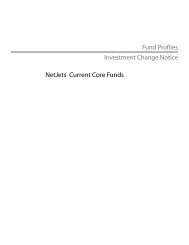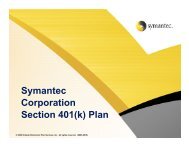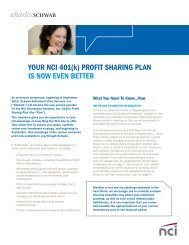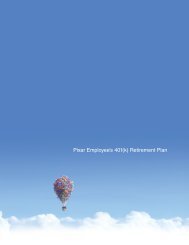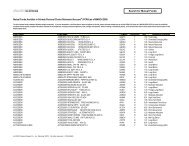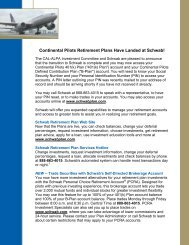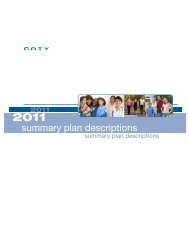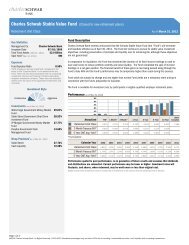MELLON STABLE VALUE FUND
Charles Schwab Stable Value Fund - Schwab Retirement Plan ...
Charles Schwab Stable Value Fund - Schwab Retirement Plan ...
- No tags were found...
You also want an ePaper? Increase the reach of your titles
YUMPU automatically turns print PDFs into web optimized ePapers that Google loves.
Mellon Stable Value Fund<br />
EXPENSE INFORMATION<br />
Fees and expenses are only one of several factors to consider when<br />
making investment decisions. Following are the expenses you would<br />
incur as an investor in the Fund. The expenses are provided as a<br />
percentage of the average net asset value of the Fund, and as a dollar<br />
amount of expenses assuming a one-year investment of $1,000 with<br />
no change in the Fund’s performance. Your actual costs and returns<br />
will vary. See the “Fees and Expenses” section for additional<br />
information.<br />
TOTAL ANNUAL <strong>FUND</strong> OPERATING EXPENSES<br />
Class Z – zero fee share class (billed outside fund) 0.26%<br />
Class Z $2.60<br />
Class M – 15 basis point share class 0.41%<br />
Class M $4.10<br />
Class Ja – 30 basis point share class, 15 basis points to the Trustee<br />
and 15 basis points to the service provider. 0.56%<br />
Class Ja $5.60<br />
Class Jb – 30 basis point share class, 20 basis points to the Trustee<br />
and 10 basis points to the service provider. 0.56%<br />
Class Jb $5.60<br />
Class Ia 50 basis point share class, 15 basis points to the Trustee<br />
and 35 basis points to the service provider. 0.76%<br />
Class Ia $7.60<br />
Class Ib 50 basis point share class, 20 basis points to the Trustee<br />
and 30 basis points to the service provider. 0.76%<br />
Class Ib $7.60<br />
<br />
The Fund's expense ratio and performance information includes the<br />
actual outside audit expenses charged to the Fund. The Fund’s<br />
expense ratio and performance also include the underlying product<br />
fees associated with synthetic wrap contracts of 15 basis points,<br />
insurance company separate account, pooled fund and underlying<br />
asset management fees of fees of 11 basis points, which are<br />
embedded in those contracts’ crediting rates. These fees are<br />
approximate and may vary. The expense ratio and performance for<br />
Class Z Shares do not include external management fees that the<br />
Fund charges to the Plan.<br />
Please note that this presentation does not comply with all of the<br />
disclosure requirements for an ERISA “section 404(c) plan,” as<br />
described in the Department of Labor regulations under section<br />
404(c), nor does it contain all of the disclosure required by Rule 404a-<br />
5. Plan sponsors intending to comply with those regulations will need<br />
to provide the plan participants with additional information. The<br />
information provided in this presentation does not constitute<br />
individual investment advice for a participant or investor, is only<br />
informational in nature and should not be used by a participant or<br />
investor as a primary basis for making an investment decision.<br />
Participants should consult their financial adviser to determine their<br />
investment risk and tolerance, and evaluate if the Fund is suitable for<br />
their retirement needs.<br />
SHARE CLASS IDENTIFIER<br />
Share class Cusip Sub classes<br />
Z 58552T106 N/A<br />
M 58552T205 N/A<br />
J 58552T304 a and b<br />
I 58552T403 a and b<br />
TOP 5 CONTRACT ISSUERS (%)<br />
Prudential 14.9<br />
American General Life Insurance Company 14.5<br />
Pacific Life 14.4<br />
Athene Annuity & Life Company 11.9<br />
New York Life 8.9<br />
THE <strong>FUND</strong>, ITS OBJECTIVE, ITS PRINCIPAL INVESTMENT STRATEGY<br />
AND PRINCIPAL RISKS<br />
The objective of the Fund is current income while maintaining<br />
stability of invested principal. The Fund pursues its objective by<br />
investing primarily in a diversified portfolio of fixed-income<br />
instruments which may include traditional guaranteed investment<br />
contracts (“GICs”) (obligations of creditworthy life insurance<br />
companies), separate account GICs, synthetic GICs (high-quality debt<br />
securities including mortgage-backed, commercial mortgagebacked,<br />
asset-backed and corporate securities held by the Fund<br />
within contracts that are intended to minimize market volatility),<br />
variable rate GICs, repurchase agreements, US treasury and agency<br />
securities, and cash and cash equivalents, including certificates of<br />
deposit and money market instruments. The Fund may also invest in<br />
a collective fund or group trust (including but not limited to one<br />
maintained by BNY Mellon or its affiliate) that invests in such fixed<br />
income instruments, and the terms of such collective fund or group<br />
trust are hereby incorporated by reference in the Fund and shall be<br />
part of the Fund. A portion of the Fund may be invested in one or more<br />
money market mutual funds sponsored, managed, advised,<br />
subadvised, administered or distributed by a parent, subsidiary or<br />
affiliate of BNY Mellon to the extent consistent with ERISA. Such an<br />
investment may include units of a fixed income fund that are held by<br />
the Fund as part of a synthetic GIC.<br />
No investment contract in which the Fund invests will have a duration<br />
of more than six years from the date of issuance. The Fund will<br />
operate with a weighted average duration selected by BNY Mellon, in<br />
its capacity as Trustee of the Fund from time to time, but such<br />
weighted average duration generally will average between 1.0 and 3.0<br />
years. In order for a GIC to be accepted into the Fund at the time of<br />
the investment, the issuer of the GIC must be rated on The Stable<br />
Value Issuer Universe, comprised of creditworthy insurance<br />
companies and commercial banks that are approved by BNY Mellon<br />
for purchase of GICs and synthetic GICs in the Fund.<br />
The Fund will be diversified, will not concentrate in securities of<br />
issuers of a particular industry or group of industries, and will not<br />
participate in securities lending directly, but may invest a portion of<br />
its assets in underlying collective investment funds that engage in<br />
securities lending.<br />
SUMMARY OF PRINCIPAL RISKS<br />
Depending on the Fund’s investment allocations, the Fund is exposed<br />
to varying degrees of the following principal investment risks, each of<br />
which may adversely affect the Fund’s unit value, its performance<br />
and the ability to achieve its investment objective:<br />
Asset-backed securities risk. General downturns in the economy<br />
could cause the value of asset-backed securities to fall. In addition,<br />
asset-backed securities present certain risks that are not presented<br />
by mortgage-backed securities. Primarily, these securities may<br />
provide the Fund with a less effective security interest in the related<br />
collateral than do mortgage-backed securities. Therefore, there is the<br />
possibility that recoveries on the underlying collateral may not, in<br />
some cases, be available to support payments on these securities.<br />
Call risk. Some bonds give the issuer the option to call, or redeem, the<br />
bonds before their maturity date. If an issuer “calls” its bond during a<br />
time of declining interest rates, the Fund might have to reinvest the<br />
proceeds in an investment offering a lower yield, and therefore might<br />
not benefit from any increase in value as a result of declining interest<br />
rates. During periods of market illiquidity or rising interest rates,<br />
prices of “callable” issues are subject to increased price fluctuation.



